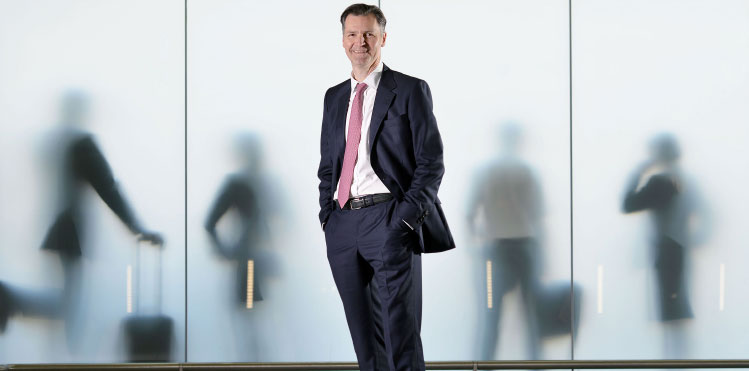
John Holland-Kaye, CEO Heathrow Airport: “We are closing Terminal 1 on 29 June. The next phase will be to demolish Terminal 1 and extend Terminal 2, and then close Terminal 3. This will provide Britain with a brand new, world-class airport.”
An interview with John Holland-Kaye, CEO Heathrow Airport. By Amy Hanna.
Heathrow Airport experienced its busiest ever year in 2014, handling 73.4 million passengers – a 1.4% year-on-year increase. New routes and additional flights launched to mature and emerging long-haul markets were among the drivers for growth, including Manila, Chengdu, Bogota and Austin, Texas. Air China also consolidated its London operations into Heathrow.
More efficient use of the hub is key in driving up passenger numbers when operating at 98% slot capacity, and by the end of 2014, Heathrow also had more airlines operating 787s than any other airport globally, while the number of airlines operating A380s increased to seven, benefiting from the direct demand to use Heathrow and the hub capabilities for quick transfers.
“We expect to continue to grow and to beat year-on-year records through the use of larger and fuller aircraft, and some new short and long-haul routes, albeit at a slower rate than 2014,” John Holland-Kaye, CEO Heathrow Airport, commented. “However, our scope to do so is limited by our capacity constraint. With a queue of 30 airlines waiting for slots at Heathrow at any one time, demand for routes at Heathrow well outstrips supply.”
The biggest challenge for the airport is continuing to provide outstanding passenger service, operational resilience and meeting demands for additional connectivity as the UK’s largest gateway, while operating at 98% capacity. Holland-Kaye explained that “the biggest opportunity will be the outcome of the government’s decision on airport expansion”. He, naturally, believes that Heathrow’s proposal is best for Britain and added that expansion would give it “the opportunity to operate up to 40 new long-haul routes and overhaul our cargo facilities, doubling the capacity”.
Maximising economic benefits; managing environmental responsibilities
Heathrow is building on its successes by focusing on a number of key operational priorities. In 2014 it opened the Airport Operating Centre (APOC), which brought together people and information in one place, including the airport service partners like the police and Border Force. “We are already seeing an improvement in the way the airport works – keeping passengers, bags and aircraft flowing, and reducing wait time and delay, while improving forward planning and resilience,” Holland-Kaye said.
The next phase is to continue to improve the way APOC captures and then uses the operational data and information it gets, to plan ahead and work to a daily plan so that passengers notice an improved experience. “We are closing Terminal 1 on 29 June. The next phase will be to demolish Terminal 1 and extend Terminal 2, and then close Terminal 3. This will provide Britain with a brand new, world-class airport,” Holland-Kaye enthused. “In the short-term, we are improving the passenger experience in Terminal 3. We are expanding the transfer area and adding new passenger facilities in the departure lounge.”
Heathrow’s expansion is being undertaken with a new approach, putting the local community firmly at its heart. In February, it announced a new noise insulation scheme, with the expansion aiming to reduce the impact of noise and treat local people fairly. “In total, we estimate that we would invest over £700 million (€1bn) on the offer, which would see homes in the designated zone closest to the airport with higher levels of noise stand to have the full costs of their noise insulation covered by the airport,” Holland-Kaye explained.
In addition, up to £3,000 (€4,000) in noise insulation would be offered to homes further away from the airport, subject to government policy support and regulatory approval by the CAA. “It’s an offer which goes above and beyond UK policy requirements, builds on Heathrow’s previous proposals and is comparable to those offered by other European hub airports,” Holland-Kaye added.
Indeed, Heathrow believes you don’t have to choose between the passenger and the local resident – it’s possible to do the best for both. That’s why it’s working hard to maximise the economic benefits that Heathrow brings, while carefully managing its environmental responsibilities as it strives to be a good neighbour to its local communities.
“It’s critical to ensure expansion delivers economic growth in a sustainable way and guarantees those most impacted by expansion get the greatest benefits and are treated fairly,” Holland-Kaye concluded.







